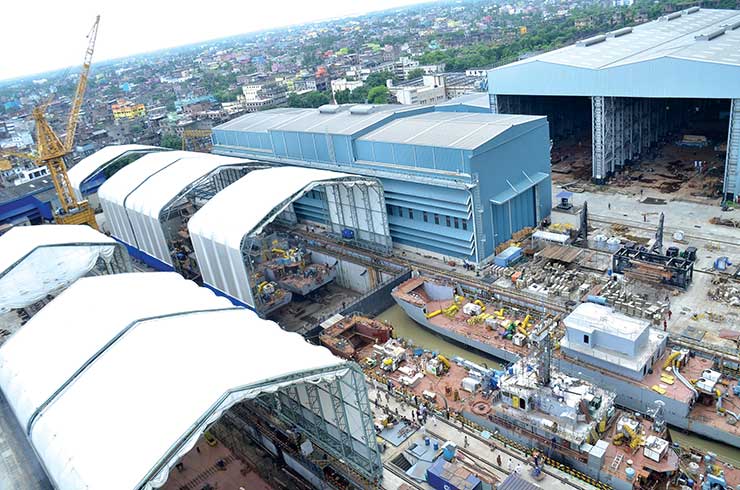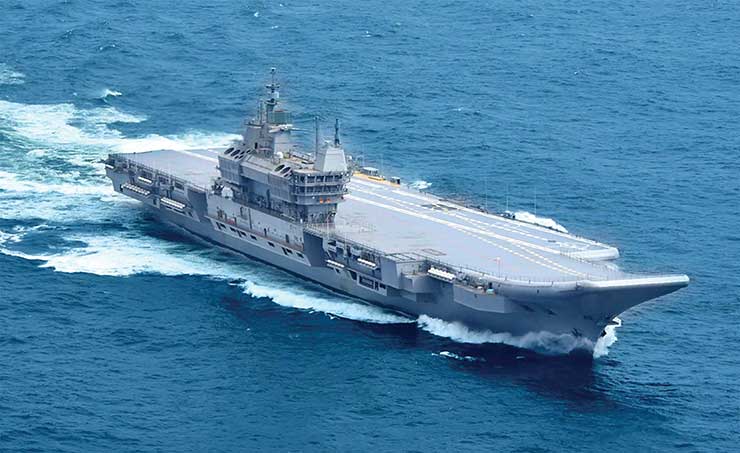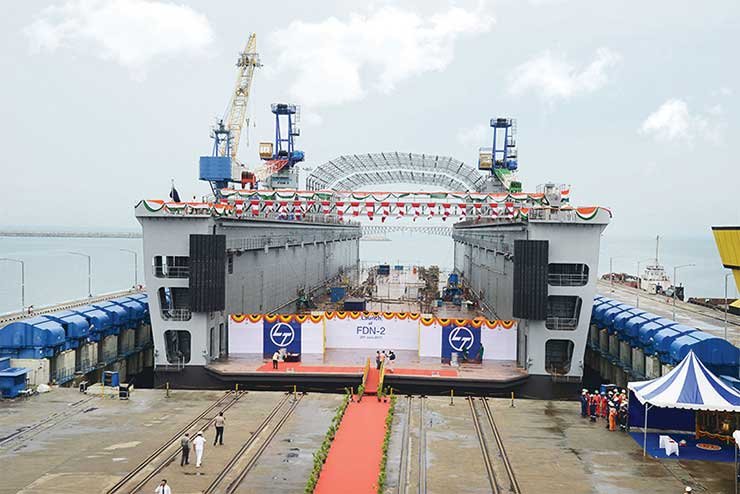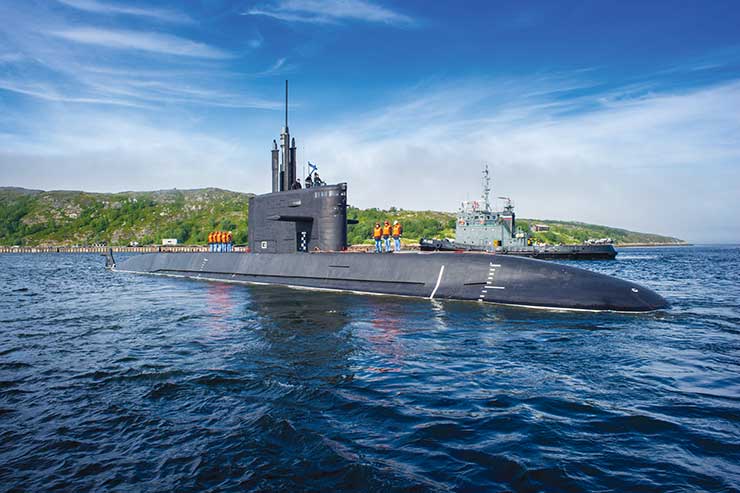
The Indian Navy is faced with a strange dilemma. While it needs to augment its force levels to meet the emerging threats to India’s maritime security over the next decade, it is actually being forced to revise its force-level projection downwards. There are many reasons behind this. The lack of adequate shipbuilding capacity in the country is a major reason, besides the usual budgetary constraints, but it is rarely highlighted.
Warship construction has been one of the notable success stories in the country’s efforts to enhance indigenisation in defence manufacturing. The Navy’s emphasis on indigenous design and construction of its warships predates the current government’s buzzwords of ‘Make in India’ and ‘Aatmnirbharta’ (self-reliance) by many decades. In the last two decades or so, all warships and submarines have been built in Indian shipyards, except for a few exceptions. Presently too, other than two warships likely to be procured from abroad, all the remaining 39 vessels or so are being built in Indian shipyards. An additional 40 odd platforms, for which the Acceptance of Necessity (AoN) has already been accorded, will also be built in the country.
Half story
Impressive as these figures may seem, they do not tell the whole story. The Indian Navy has projected a force level of 170 ships and submarines by 2027, a figure that was quoted by the previous Chief of the Naval Staff during his annual Press Conference on the eve of Navy Day in December 2020 and reiterated by the present Vice Chief of the Naval Staff at an interaction with the media in November 2021. This is considerably less than the 200 ship navy that was being spoken about as recently as 2018 and will lead to a widening capacity deficit in certain important capabilities in the Indian Navy’s current and future force levels.
Warship construction in India is mainly undertaken by five public sector shipyards. Four of these (Mazagon Docks Ltd Mumbai, Goa Shipyard Ltd, Hindustan Shipyard Ltd Visakhapatnam and Garden Reach Shipbuilders and Engineers Kolkatta) are under the Ministry of Defence (hence referred to as DPSUs) and the fifth, Cochin Shipyard Ltd is under the Ministry of Shipping. MDL is presently building the four Project 15B destroyers, four Project 17A stealth frigates and six Project 75 submarines and is in the fry as one of the two potential Strategic Partners for the six Project 75(I) submarines. GSL, which mainly builds Offshore Patrol Vessels (OPV) and survey vessels, was earmarked for the two-decade-old MCMV programme, which remains a non-starter to this day and has also been designated to build two Type 1135.6 stealth frigates. HSL Vizag, which was taken over by the MoD a few years ago, has been nominated to build five Fleet Support Ships in collaboration with a Turkish design house and is building the navy’s Diving Support Vessels. The fourth, GRSE Kolkata, which has built the Fleet Underway Replenishment Ship INS Aditya, three Brahmaputra class frigates and four Kamorta class ASW Corvettes besides numerous other small craft including fast patrol boats and LACs, is contracted to build three of the seven P17A stealth frigates and eight ASW Shallow Water Craft. CSL, which is building India’s first indigenous aircraft carrier Vikrant, has also got an order to build eight ASW Shallow Water Craft, similar to the ones being built at GRSE.

The message that emanates from this is that the Navy’s requirement is being primarily met by these five public sector shipyards who have their hands full with existing orders but are continuing to get more orders as the approved projects get underway. However, this rosy picture tells only half the story.
Current capacity
These five shipyards presently have a confirmed order book in excess of Rs 150,000 crore and an annual turnover of less than Rs 10000 crore. Hence, with their current capacity and pace of shipbuilding, it could take well over a decade for them to deliver on their current orders while the Navy continues to wait.
Delays in either placing orders or delivering ships due to limited shipbuilding capacity are detrimental to the nation’s maritime security. It is evident that the Indian Ocean is going to witness future great power rivalry as China challenges the USA for domination of the Indo-Pacific. The PLA Navy is rapidly expanding its presence and maritime footprint westwards and will have a formidable presence in the Indian Ocean by the end of this decade. With the help of its proxies in the region, it will attempt to contain India in the maritime domain.
Lack of urgency
India, as the leading Indian Ocean power, cannot remain a bystander. Will require a full spectrum blue water capability to counter this threat and retain both, the combat edge and its primacy in the Indian Ocean. It is therefore imperative that it bridges the capacity and capability deficits that are becoming increasingly evident. To do so, it will require a higher percentage of major surface combatants than at present, which will require additional shipbuilding capacity. However, given the present pace of shipbuilding in the country and the seeming lack of urgency to address the deficits, this seems unlikely in the near term.

Recognising the need for additional capacity and the MoD’s willingness to allow warship construction in the private sector, four private sector shipyards took a leap of faith into warship construction. These were Bharti Shipyard, ABG Shipyard, Pipavav Shipyard and Larsen and Toubro’s shipyard at Katupalli near Chennai. Of these, only the L&T shipyard remains active and has delivered a range of vessels but is still awaiting a large order and is in the fray for the Project 75(I) submarines. The rest have been declared insolvent and are deep in debt. While they are largely to blame themselves for the mess they find themselves in, the MoD too cannot be absolved for not providing an enabling environment or the encouragement for these shipyards to develop the skills, expertise and experience as part of an effort to augment the national shipbuilding capacity. It often seemed that the department of defence production in the MoD was more concerned about protecting its own shipyards from private-sector competition rather than creating a level playing field for them to also improve their own efficiency. In the initial stages, it took a great deal of convincing by the Navy and the HQ IDS to include the private sector in warship building in the Defence Procurement Procedure itself. As a consequence, and to pay lip service to the private sector, a few contracts were concluded with the private sector shipyards but at such competitive prices that these were economically unviable from the very beginning. However, being desperate for orders, these yards grabbed whatever was on offer and it was not surprising that they crumbled under their own debt burden and were unable to deliver.
It is indeed ironic that while these yards were expected to deliver results at extremely competitive prices despite being new at the business and were penalized for not being able to do so, the public sector shipyards despite MoD’s support and being in this business for decades have rarely if at all, delivered any major programme either on time or within cost.
The consequence is that the country has been unable to augment its warship building capacity, the Navy has lost out on getting the ships that were being built at these yards and shipbuilding skills developed at considerable cost at these yards have gone to waste.
Delays in warship construction are not unique to India. Most major programmes all over the world experience delays for a multitude of reasons associated with the complexities of warship and submarine construction. At a time when India should have been strengthening its warship building industry towards promoting self-reliance, indigenization and the capacity to build and export to friendly foreign countries in our maritime sphere of influence, we have ended up with the inadequate capacity to even build enough platforms for our own Navy’s future requirements. This has left room for our principal adversary to increase its military leverage in our immediate neighbourhood by exporting ships and submarines to Thailand, Sri Lanka, Myanmar, Bangladesh and Pakistan.
Complex process
Warship construction is a complex process and cannot be done in fits and starts. It takes time to build the infrastructure and skilled human resources and the need thereafter should be to consolidate this by ensuring a series production of specialized platforms. India built two submarines in the early 90s with technical assistance from HDW Germany. This should have been the springboard to becoming a submarine-building nation. However, for reasons that are well known, this line was discontinued after building just two submarines and over a period of time, the skills were lost. The country again started from scratch with Project 75, which is also nearing completion but the next programme is still some distance away.

The 30 Year Plan for indigenous submarine construction was developed and approved way back in 1999 with the aim of ensuring a sustained submarine-building capability in the country. That plan has been followed more in the breach and instead of the envisaged 20 odd submarines by 2030, the Indian Navy would have got only six.
Aircraft carrier
A similar fate is likely to befall the aircraft carrier programme. Vikrant, the country’s first indigenously built aircraft carrier, is at an advanced stage of sea trials and is likely to get commissioned by the middle of this year. However, the plans for a new aircraft carrier are stagnating with little or no inclination on the part of the government to accord approval. It will be a shame if this complex skill of building aircraft carriers is also allowed to go to waste.
One of the hallmarks of a powerful navy is its ability to project power in its primary area of responsibility and protect the country’s interest anywhere across the globe. As India grows to a $5 trillion economy by 2025-26 and a $10 trillion economy by 2032, its trade and energy requirements, most of which transit over the sea will increase exponentially in volume and value. Protecting its Sea Lines of Communication (SLOC) as well as its economic interests in the maritime domain as humankind turns increasingly to the sea for its future sustenance will require the Indian Navy to be structured accordingly. Critical capability gaps across the surface, subsurface and in the air will need to be addressed with the urgency they deserve.
Navies do not get built in a day. Maritime warfare is as much about platforms as it is about their optimal exploitation. This includes a thorough understanding of the platform, gaining operational experience, validating operational concepts, working up of the crews onboard and creating a robust support and maintenance infrastructure. Delays in inducting platforms compromises all these and has a cascading effect on a navy’s operational capability.
India is poised on a transformational cusp in the maritime domain. The prime minister has repeatedly highlighted the centrality of the maritime sector in India’s future growth trajectory. Building the capacity to secure India’s maritime interests as it reaches out across the globe is therefore a national security imperative that can neither be ignored nor delayed.
–The writer is the Vice President of the Indian Maritime Foundation and a naval veteran. He has been closely associated with the defence procurement process in various capacities. The views expressed are personal and do not necessarily reflect the views of Raksha Anirveda









